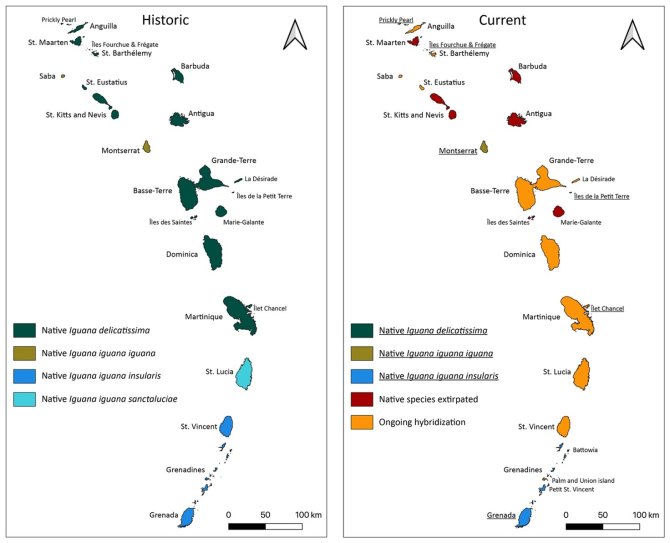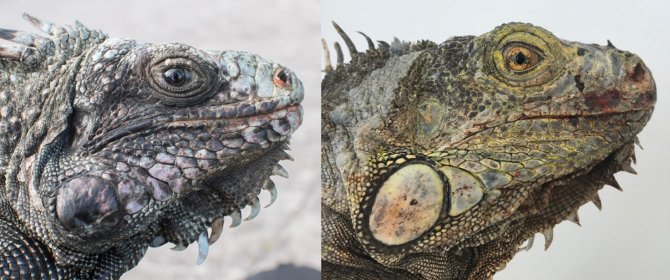Researchers of Wageningen University & Research have identified a recent incursion of non-native iguanas on Saba, which form a major threat to the endemic melanistic iguana population. A promising study shows a new methodology with which non-native iguanas can be recognised and removed at an early stage for more effective protection of native populations.
Within the Caribbean Lesser Antilles, iguanas of the genus Iguana are among the most important native keystone herbivores. Although several native species and subspecies occur here, hybridisation with non-native iguanas introduced by people or through ship and container traffic from the Central and South-American mainland is a major threat. Native iguana populations throughout the region are under extreme pressure from hybridisation and replacement by these non-native iguanas.

Replacement of native iguanas
Iguanas non-native to the Caribbean islands have their natural home in Central and South America and are most commonly brought to the Lesser Antilles as stowaways in shipping containers, on boats or as released or escaped pets. They are larger and more competitive than native Caribbean iguanas and lay many more eggs than the latter.
As soon as non-native iguanas become established, the process of hybridisation and competitive replacement will lead to the eventual extinction of the local native population. During this process, the overall iguana population size often also increases rapidly and becomes a local pest, as can be seen in the Cayman Islands, for example.
Local governments and NGOs need to act immediately to remove non-native iguanas once these are identified to be present
Novel recognition methodology
Non-native iguanas need to be recognised as fast as possible in order to be captured and removed from native populations. However, as iguanas are morphologically extremely variable, coloration and scale differences are not always useful for distinguishing native specimens from non-native ones. Differences in morphometric characteristics have not been assessed until now.
This study, lead by Wageningen University & Research in collaboration with the Durrell Wildlife Conservation Trust and the Montserrat National Trust, highlights that, notably, these characteristics and ratios can be important indicators in the recognition of non-native iguanas. Results show that the characteristic scale on the lower jaw is remarkably larger for non-native iguanas compared to native iguanas. Because only few non-native iguanas occur on Saba, additional diagnostic characteristics might yet be discovered, but this initial study provides at least one approach for rapid recognition in the field. The involved scientists call on their regional colleagues to conduct intensive research into morphometrics within local native iguana populations as soon as possible. Through such efforts, new data sets can be built that allow rapid non-native identification.
Keystone species
Similar to other ecological keystone species, a healthy native iguana population is a measure for the vitality and resilience of the insular terrestrial ecosystem, in which the iguana plays a key role as a herbivore in the endangered Caribbean dry forest on the Windward Islands. Female iguanas also mix soil and nutrients when nesting, while hatchling iguanas form an important nutritional source for many (migrating) bird species. Furthermore, iguanas stimulate leaf and flower growth of native plant species. Finally, consumption of fruits by iguanas distributes seeds and promotes their germination, as well as the survival of young plants. A healthy iguana population is therefore crucial for ecosystem health and will aid nature and habitat recovery.
Saba situation
Saba is home to one of the last remaining native Iguana populations in the Lesser Antilles that, until recently, was not directly threatened by non-native iguanas. Though long overdue, research into this unique population is ongoing, and the first results of these efforts are already clear. The iguana population was found to be larger than initially expected and occurred island wide, even though feral cats (predation) and goats (erosion and habitat degradation) are major threats. Partly because of this, there appeared to be very few juvenile iguanas within the Saba population. The most urgent threat, however, is the presence of alien iguanas.
Thus far, our research indicates that non-native iguanas are present in small numbers in (at least) two areas on Saba. DNA analysis shows that these animals originate from Curaçao and Central America and probably ended up on Saba indirectly via the port of St. Maarten. There is a large invasive and non-native iguana population on St. Maarten and almost all freight traffic to Saba travels via St. Maarten, allowing iguanas to hitch a ride among the freight. Therefore, controlling the iguana population in the port of St. Maarten and fumigation of container shipments would be a valuable step towards protecting the remaining native iguana populations of the Lesser Antilles.

The new studyhas been published in Animal Conservation:
M.P. van den Burg et al.: An integrative approach to assess non-native iguana presence on Saba and Montserrat: are we losing all native Iguana populations in the Lesser Antilles? Animal Conservation 2023, ACV12869. https://doi.org/10.1111/acv.12869






